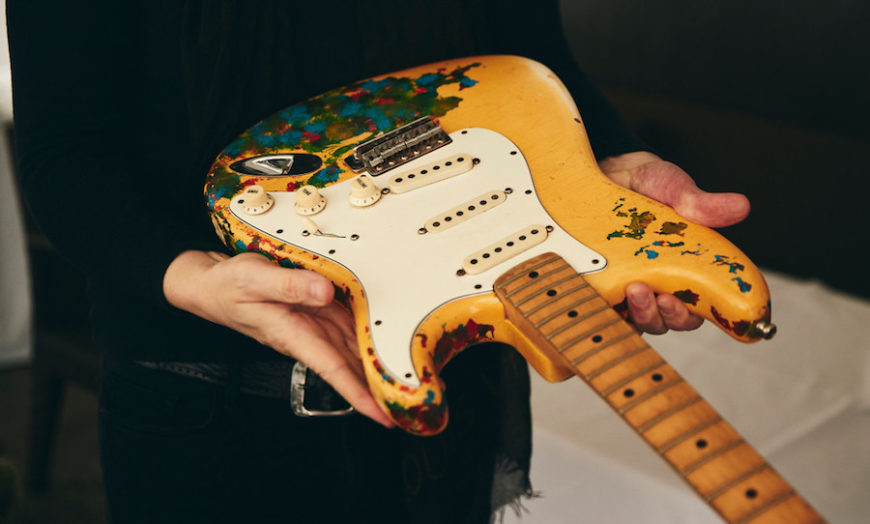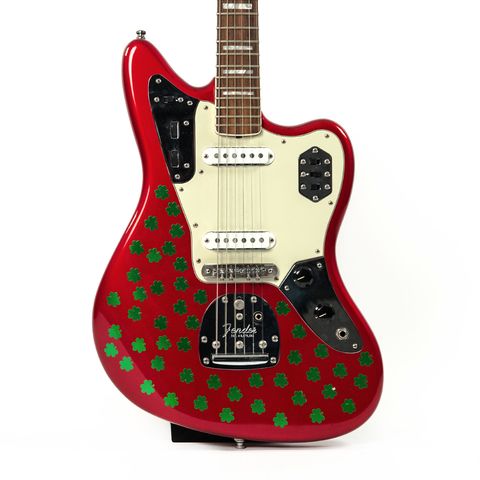

“The minute I started playing on the Strat, it was like it came to life,” he says. Because he is a southpaw who plays on righty instruments (his dad told him he’d never find good guitars if he played left-handed), it was the first time he could really feel what he was playing. The difference, he explains, was the instrument’s neck, which he describes as being like that of a violin. “When it was stolen, it wasn’t like, ‘Oh, gee, my guitar just got stolen.’ It was the guitar that affected the way I played and I was heavily identified with the guitar.” “It instantly changed the way the band sounded and the way I played,” Corgan says. He’d grown up playing Gibson Flying V guitars because that’s what his father played, but this one suited him differently. The Pumpkins’ drummer, Jimmy Chamberlain, had sold it to him around 1989 or 1990 for $275, and he’d never played a Stratocaster before. The guitar has a particularly special meaning to Corgan, since it changed the way he played the instrument. But he looked down, and as she opened the case, he looked at it for a second and froze. “He doesn’t give a lot of facial expressions. “If you look at Billy, he’s very stoic,” says Heiche, who coordinated the reunion. This past December, her friend’s brother connected her to Alex Heiche, who founded Sound Royalties, a company that offers royalty financing to artists in need of quick money. She tried sending Corgan a Facebook message about six months ago but didn’t get through to him. Her friend had recognized it from an article online and said, “Isn’t this the guitar you have in your basement?” “I just freaked out and I’m like, ‘I don’t know,'” she says. She’s not much of a Smashing Pumpkins fan – she’s more into the Rolling Stones - but she recognized a few of their songs when a girlfriend of hers helped her connect the dots about the instrument’s provenance. I didn’t know if it is or not and then I got the article about it.” “People always said it was probably worth some money. “I really wanted a hot tub, frankly, and my husband wouldn’t buy me one, so I said, ‘Well I’m gonna sell some of this stuff,'” she says. Her daughters never played the instrument and it resurfaced as she was looking for things to sell. I actually told my husband I only paid $100 for it because he would have killed me if he found out I paid more.” And there it stayed for the last 10 to 12 years. “I literally don’t know anything about the guitar.

“I thought it was painted cool,” she says. She’d spotted the guitar at a Detroit yard sale and plonked down $200 for it because she thought it would be a cool conversation piece in her basement.

The guitar made its way back to him via Beth James, a mother of three who doesn’t play guitar and lives in Flushing, Michigan, about 80 minutes northwest of Detroit. He recognized the place where a previous owner had carved the initials “KM” into it, and he remembered the placement of certain cigarette burns on the headstock “that I always thought were unsightly.” These were things he’d never talked about in the press, so it would have been impossible for someone to copy them. Sure enough, it was the early Seventies Fender Stratocaster that he had been looking for for more than 25 years.Ĭorgan knows it’s his guitar because it had certain distinguishing marks beyond the psychedelic paint job he’d given it. You could have fooled me.” So he decided to check it out in person. “And he wrote back, ‘Oh, it’s a recreation.’ He’d literally gotten the same stickers, worn them down in the same way and scraped the paint so it looked worn. “Somebody sent me a picture a couple of weeks ago of another one of my guitars, and I wrote the guy back and said, ‘How did you get my guitar?'” he says. But he was still incredulous because he’d been tricked before. A friend of his contacted him with a picture of a guitar that looked like the stolen instrument. “It was like the lost treasure of Blackbeard or something.” “It got to the point where you started not believing it, because you heard it so many times,” he tells Rolling Stone. “I was like, ‘How is that even possible? Where’s security? Where were you?'” He filed a police report and offered a $10,000, no-questions-asked reward for its return.įor the past 27 years, he’s heard rumors of the guitar resurfacing. The band had just finished a gig at Detroit’s Saint Andrew’s Hall in June 1992 when a friend who was acting as a roadie told him, “Somebody just walked out the back door with your guitar.” It hadn’t even been five minutes since the band finished the show, as Corgan recalls. About a year after Smashing Pumpkins issued their fuzzy, trippy debut, Gish, a thief stole Billy Corgan’s favorite guitar.


 0 kommentar(er)
0 kommentar(er)
